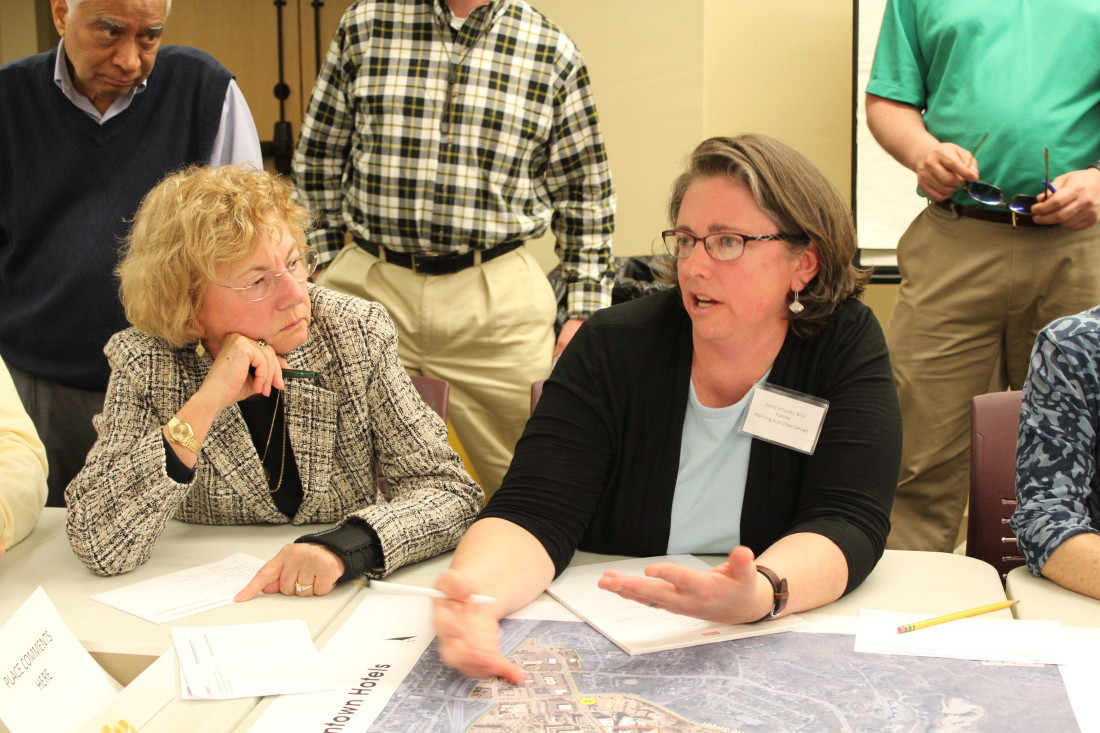The city asked for input on downtown development review standards and, if turnout can be considered an indication, it certainly got it. At least 124 members of the community signed in for an open house-style meeting about development issues in downtown Asheville on March 23.
Some attendees, however, expressed doubts about how effective the session would be, given the crowding and noise. “I can’t hear a thing they are saying,” commented real estate broker Jim Diaz as he walked around to the small group clusters where planning staff discussed development review practices for different downtown zones, height standards and hotel development. Luckily, he continued, he was familiar with the issues being discussed.
Downtown resident Inge Durre had a similar concern: “The city is having too many public input meetings right now. We see the same people at every meeting. Then, when you get there, it’s very disorganized. If the city wants to form a coalition of residents to provide input, it needs to be more clear how citizens can participate in a productive way.”
City planning staff were clearly working hard to provide information and receive input. All attendees were offered comment cards at check-in and during the session. City Council members Brian Haynes and Julie Mayfield, along with City Manager Gary Jackson, participated in the session at different times throughout the drop-in.
At 4:15 p.m. and again at 5:45 p.m., City Planning and Urban Design Director Todd Okolichany and Assistant Director Alan Glines delivered a brief presentation on the recent history of downtown review guidelines and the issues on which the city is seeking input.
City Council has asked the planning and urban design department to reexamine development rules for the central business district in light of recent concerns about the pace of new development and the number of projects (particularly hotel projects) currently underway, Okolichany said.
The backstory for the current development rules began in 2007, he continued. Two tall structures were proposed for downtown: a 23-story hotel tower (258 feet high) and a 25-story condominium tower (340 feet high). Rules in place at that time did not prohibit such tall buildings in the historic core, and community members felt that their desires were not reflected in the review process or the building code.
To address those concerns, a planning process that would eventually involve 14 public meetings and reflect over 4,000 hours of community time was launched. The resulting Downtown Master Plan was completed in 2009, and new downtown review standards consistent with the plan goals were adopted in 2010. While previous rules had required City Council approval for projects greater than 100,000 square feet in size, the 2010 rules raised that threshold to 175,000 square feet or over the intermediate height zone of 145 feet (to a maximum of 265 feet).
Glines pointed out that the pre-2010 standard remains the current practice for projects within the city limits but outside of the Central Business District.
Currently, in the downtown area, projects under 20,000 square feet require staff review and approval.
Projects between 20,000 and 175,000 square feet and up to 145 feet tall require:
- Developer to hold a public meeting
- Technical review by various city departments
- Downtown Commission design review
- Planning & Zoning Commission review
- Approval by Planning & Zoning Commission
Larger projects require all of the steps above, plus City Council review and approval. Between 2010 and 2015, only four projects were reviewed by City Council, three of which were public buildings (two courthouse projects and the new Health and Human Services building on Coxe Avenue).
Under the current standards, no hotel projects approved before the end of 2015 required City Council review. The redevelopment of the former BB&T building at Pack Square (which contains a hotel component, along with condominiums, restaurants and a small amount of retail), however, did require City Council approval, which it received in January 2016.
Council seeks input as it considers whether the size and/or height thresholds that trigger Council review should be lowered. Another issue is the distinction between conditional zonings and conditional use permits downtown.
According to a city press release:
Currently, there is an area called the Traditional Downtown Core. Large projects within this boundary are reviewed as Conditional Zonings, outside of this area, large projects are reviewed as Conditional Use Permits. The difference between these two processes are technical, but have an impact on both how City Council receives information about the project, and how the project is reviewed.
Finally, Council also has indicated that it will reconsider the process for reviewing hotel construction in light of community concerns.
The city’s press release explains:
Hotels could be reviewed under a Conditional Use Permit or Conditional Zoning as a category. One possibility is that hotels over a certain size or number of rooms could be considered either Conditional Use or Conditional Zoning. No thresholds have been determined yet.
Glines asked attendees to provide feedback about whether hotels should be evaluated differently than other development projects.
In one of the small groups, planner Vaidila Satvika explained, “We are open to all kinds of feedback on hotels.”
Asheville residents wishing to provide input can contact the coordinator of the event, planner Sasha Vrtunski, at svrtunski@ashevillenc.gov or call 828-259-5560.






Given the number of additional hotel guests and condo residents in the downtown area, City Council also needs to stipulate mandates for public space at the street level for these buildings, and widened sidewalks to accommodate all the new pedestrians. It would be wonderful if our sidewalks could accommodate tables for dining– but currently that would be virtually impossible given the widths of the sidewalks along Biltmore and Lexington.
Widening sidewalks would mean getting rid of curbside parking, as there are no traffic lanes to sacrifice for it. I have never used, and would not miss, curbside parking, but I seem to be in the minority on this when I talk to my peers.